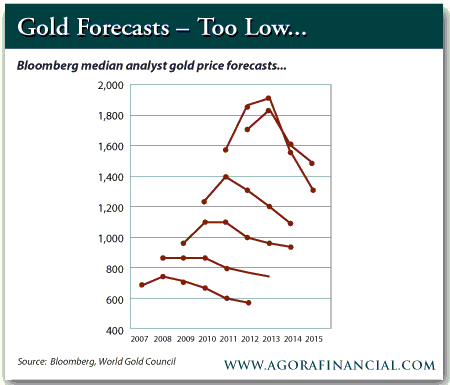|
|||
Chronically low gold price forecastsSteve Saville The following is excerpted from a commentary originally posted at www.speculative-investor.com on 29th November 2012. The chart displayed below was taken from a recent article at The Daily Reckoning and shows the median gold price forecasts of analysts monitored by Bloomberg. It shows that from 2007 onwards the average forecast has been for the gold price to be flat or higher over the coming 1-2 years and to then decline sharply such that the price is much lower after 4-5 years. For example, in 2007 the average forecast was for the gold price to trade at $650-$700 during the current year, move up to $750-$800 during 2008, and then decline to below $600 by 2012. They have always expected the price to be lower in 4 years than it is today. Despite being consistently wrong, they still expect the price to be lower in 4 years than it is today. This is absolutely not the sort of sentiment that would likely be evident if gold's long-term bull market were near its end. There's a high probability, verging on a certainty, that near the end of gold's bull market the average analyst will be forecasting an upward price-trend extending many years into the future.
On a different matter, the article linked above contains some serious errors. One notable error is the assertion that China and India account for 47% of the demand for gold. To make this assertion you have to make the mistake of applying a traditional commodity-type analysis to the gold market. With all commodities except gold the so-called stocks-to-flow ratio is relatively low, meaning that the amount of the commodity held in inventory (warehouses, storage containers, vaults, etc.) is low compared to the amount consumed in commercial processes. It is almost always less than one year and is often just a few weeks. This means that when doing a supply-demand analysis for any commodity except gold it will generally make sense to compare the current year's consumption to the current year's new production. With gold, however, the existing above ground supply is more than 75-times greater than annual mine production. This means that if the entire gold mining industry were to shut down for a year it would not make a significant difference to total gold supply. It also means that it makes no sense to compare the amount of gold sold in a country in a year with the world's new mine supply and to use the result of this comparison as an indicator of that country's contribution to global gold demand. A related error is to downplay the actions of the Fed. The US$ gold price is mostly determined by the general perception of what's happening and what's likely to happen to the US$, which, in turn, is mostly determined by the actions of the Fed. For example, a negative real interest rate constitutes a powerful bullish force in the gold market, but real interest rates in the US could not be negative in the absence of the Fed. Gold is a global market and what happens to gold demand in one part of the world can have an effect on how gold is priced in another part of the world, but gold is never going to make large and sustainable gains relative to a sound currency. If, for example, the US$ were suddenly transformed into a sound currency due to the Fed making a credible promise not to further inflate the US$ supply, we have no doubt that the US$ gold price would decline to a much lower level regardless of what was happening in China and India. In this hypothetical situation the gold price would decline in US$ terms, but it wouldn't necessarily decline in terms of any other currency. The main reason to be bullish on the US$ gold price is that the ignoramuses at the upper echelons of the Fed truly believe that they can help the US economy by conjuring money out of nothing. The weaker the economy becomes the more money they will create, and the more money they create the weaker the economy will become. ### Steve Saville Regular financial market forecasts and analyses are provided at our web site: We aren't offering a free trial subscription at this time, but free samples of our work (excerpts from our regular commentaries) can be viewed at: http://tsi-blog.com Saville Archives |

